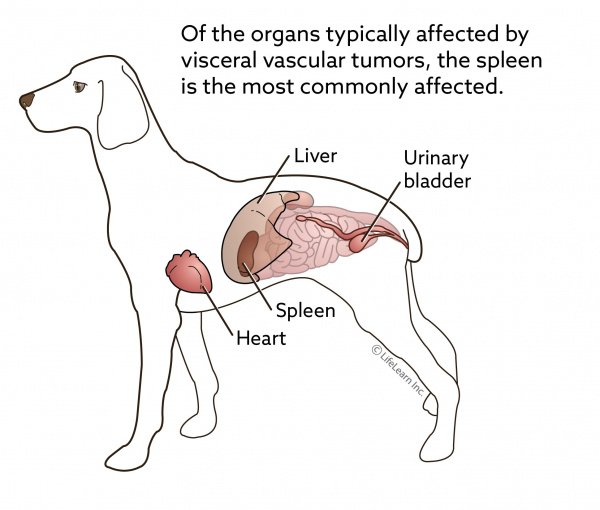Can a dog live without a spleen? The answer is yes! As integrative veterinarian Dr. Julie Buzby explains, while the spleen has many important roles in the body, it isn’t necessary for survival. Dr. Buzby also helps ease the minds of dog parents whose beloved pup is facing a splenectomy by discussing why dogs might need a splenectomy and what to expect after the surgery.
No dog parent ever wants to hear from their veterinarian that their dog needs to go to surgery, especially for an emergency procedure. And if you were told that a major internal organ needed to be removed from your dog it may be especially overwhelming and scary! However, if your dog needs to have his spleen removed (a surgical procedure called a splenectomy) the good news is that dogs can not only survive—but also thrive in many cases—without a spleen.
But before we dive into the “whys” and “what to expects” of splenectomies, let’s take a closer look at this marvelous organ.
Have you ever wondered if your furry friend could survive without their spleen? Maybe your vet just delivered some scary news about a splenic mass, or you’re researching after an emergency diagnosis. I’ve got good news for you – yes, dogs absolutely can live without a spleen! In fact, many pups go on to live normal, happy lives following spleen removal surgery.
As a dog owner myself, I know how terrifying it can be when our four-legged family members face health challenges. That’s why I’ve put together this comprehensive guide about canine splenectomy (fancy medical term for spleen removal) and what you can expect if your dog needs this procedure
What Does a Dog’s Spleen Actually Do?
Before we dive into living without a spleen, let’s understand what this mysterious organ actually does. The spleen is an oval-shaped, flat organ located in your dog’s abdomen, just behind the stomach. While not as famous as the heart or lungs, the spleen performs several important functions:
- Blood Storage: Think of the spleen as your dog’s personal blood bank, storing red blood cells that can be released during emergencies like hemorrhage or blood loss
- Old Cell Removal: It helps filter out and remove old, damaged red blood cells from circulation
- Infection Control: The spleen helps manage red blood cell infections by “pitting” (removing infected portions of cells)
- Immunity Support: As a lymphatic organ, it helps produce antibodies and immune cells
Despite these helpful functions the spleen isn’t considered a vital organ. Other parts of your dog’s body can take over these jobs when necessary.
Why Would a Dog Need Their Spleen Removed?
There are several reasons why your vet might recommend removing your dog’s spleen:
Splenic Masses or Tumors
The most common reason for splenectomy is the presence of masses or tumors. These can be either:
- Benign tumors: Like hemangiomas or hematomas
- Malignant tumors: Such as hemangiosarcoma (the most common malignant splenic tumor)
Even benign tumors usually warrant removal because the spleen is highly vascularized (has lots of blood vessels), and any mass carries the risk of rupture and internal bleeding.
Splenic Rupture
The spleen is a fragile organ. Traumatic injuries – like being hit by a car or experiencing blunt force to the abdomen – can cause the spleen to rupture. This leads to life-threatening internal bleeding that requires emergency surgery.
Splenic Torsion
Sometimes the spleen can twist on itself (torsion), often in conjunction with gastric dilatation-volvulus (GDV or bloat). This condition is more common in large, deep-chested breeds.
Other Conditions
Less commonly, dogs might need a splenectomy due to:
- Severe infections
- Immune-mediated diseases
- Blood clots to the spleen
- Cushing’s disease complications
The Splenectomy Procedure
If your dog needs a splenectomy, here’s what you can expect:
Types of Splenectomies
There are two main approaches:
- Total splenectomy: The entire spleen is removed (most common)
- Partial splenectomy: Only a portion of the spleen is removed (rare, usually only for trauma cases)
Before Surgery
Your dog will typically undergo:
- Physical examination
- Blood work
- Diagnostic imaging (X-rays, ultrasound)
- Fasting before anesthesia
During Surgery
The procedure is straightforward for experienced veterinarians:
- Your dog will be under general anesthesia
- The surgeon will make an incision in the abdomen
- They’ll carefully identify and ligate (tie off) blood vessels
- The spleen will be removed
- The incision will be closed in layers
After Surgery
Your dog will likely:
- Stay hospitalized for 1-2 days for monitoring
- Receive pain medication and possibly antibiotics
- Need restricted activity during recovery
- Have sutures or staples removed about 10-14 days post-surgery
Recovery After Splenectomy
Most dogs recover well from splenectomy surgery. Here’s what the recovery timeline typically looks like:
Immediate Post-Op (1-3 days)
- Hospitalization for monitoring
- Pain management
- Possible fluid therapy or blood transfusion if needed
- Limited movement
Short-Term Recovery (1-2 weeks)
- Restricted activity at home
- E-collar or surgical recovery suit to prevent licking
- Monitoring incision for signs of infection
- Medications as prescribed
Long-Term Recovery (2+ weeks)
- Gradual return to normal activity
- Follow-up appointments
- Possible pathology results and treatment plan
Life Without a Spleen: What to Expect
So what happens when your dog’s spleen is removed? Surprisingly, most dogs adapt very well to life without a spleen! Here’s what you might notice:
Physical Changes
- Some dogs may initially look thinner after surgery (the spleen can be quite large)
- Mild decrease in stamina until fully recovered
- Possible temporary changes in bowel movements
Functional Adaptations
- The liver takes over many of the spleen’s filtering functions
- Other parts of the lymphatic system compensate for immune functions
- Bone marrow increases production of new blood cells
Long-Term Considerations
- Slightly decreased immune function (mild immunosuppression)
- Potentially higher susceptibility to certain infections
- May need to be more cautious about exposure to infectious diseases
Risks and Complications
While most dogs do great after splenectomy, there are some risks to be aware of:
Surgical Risks
- Bleeding during or after surgery
- Anesthetic complications
- Inadvertent damage to nearby organs
- Infection
Post-Surgical Complications
- Incision dehiscence (opening of the surgical wound)
- Infection
- Rarely, cardiac arrhythmias
Long-Term Concerns
- Slightly higher risk of certain infections
- Potential for complications related to the underlying condition (if cancerous)
Success Stories: Dogs Living Without Spleens
To brighten the mood, let me share some real success stories from pet parents whose dogs have thrived after splenectomy:
-
Daisy the Welsh Corgi had a splenectomy on Christmas Day 2022. Once her red blood cell count normalized, she returned to her normal, active life.
-
Tucker the 12-year-old Lab underwent an emergency splenectomy after becoming lethargic and losing his appetite. After surgery, he was back to his happy self.
-
Casper the 12-year-old Jack Russell had a tennis ball-sized mass removed from his spleen. The mass was benign, and he recovered beautifully.
-
Hope the 6-year-old dog had her spleen removed in February 2022 after becoming very weak. Her surgery revealed 800cc of free-flowing blood in her abdomen. The mass was benign, and she’s now very active with no lingering problems.
When to Call Your Vet
After your dog’s splenectomy, monitor them closely and contact your vet immediately if you notice:
- Excessive lethargy or weakness
- Pale gums
- Swollen abdomen
- Difficulty breathing
- Reopening of the incision site
- Signs of infection (redness, swelling, discharge)
- Refusal to eat or drink for more than 24 hours
FAQs About Dogs Living Without a Spleen
Will my dog’s life expectancy be shorter without a spleen?
Not necessarily! If the splenectomy was performed due to a benign condition or trauma, your dog can have a normal life expectancy. If cancer was involved, prognosis depends on the type and stage.
Does my dog need special supplements after splenectomy?
In most cases, no. The body adapts to the absence of the spleen. However, some vets might recommend immune-supporting supplements in certain cases.
Will my dog be more prone to infections without a spleen?
Slightly, yes. The spleen plays a role in immune function, so your dog might be a bit more susceptible to infections. However, this is usually mild and manageable.
Are certain breeds more likely to need splenectomies?
Large and deep-chested breeds seem to have higher rates of splenic issues, especially torsion. Additionally, older dogs (8+ years) are more prone to developing splenic masses.
How much does a splenectomy cost?
Costs vary widely depending on location, emergency vs. planned procedure, and complexity. Expect anywhere from $1,500 to $9,000 or more. Pet insurance often covers some or all of this cost.
Final Thoughts
If your pup is facing this surgery, focus on finding an experienced veterinarian, following all post-op instructions carefully, and giving your furry friend lots of love during recovery. With proper care, your dog can go on to enjoy many happy, active years – spleen or no spleen!
Have you had a dog who underwent a splenectomy? We’d love to hear your experience in the comments below!

What are the signs of a spleen problem?
With all those functions, it seems that the warning signs indicating something has gone wrong with the spleen would be obvious. However, the signs of splenic dysfunction or injury can sometimes be vague or difficult to spot. Here are a few warning signs that may indicate a splenic problem:
- Swollen abdomen
- Fatigue or a lethargic dog
- Loss of appetite
- Weakness or collapse
- Pale gum color
- Weight loss
If you notice any of these symptoms, especially if they come on suddenly, call your vet ASAP or head to the nearest emergency hospital for an emergency vet visit for your dog.

Why might a dog need a splenectomy?
There are multiple issues that may necessitate the removal of your dog’s spleen. Your veterinarian may recommend a splenectomy if they suspect or diagnose one of the following conditions:
Abnormal cell growth on or within the spleen (i.e. a splenic tumor) means that the spleen may no longer function properly. This also puts the spleen at risk for rupture, which is life-threatening. Both benign and malignant masses can rupture and bleed so the presence of bleeding can’t distinguish between the two. While a fine needle aspiration (FNA) or the ultrasound may give clues about the identity of the mass, a splenic biopsy is the most definitive way to reach a diagnosis.

However, removing just a piece of the spleen for a biopsy can be dangerous. Plus, the dog may still require a splenectomy at a later date if the mass is cancerous or ruptures.
So in many cases, the vet will recommend a splenectomy. Then he or she can submit the entire spleen to the pathologist to reach a final diagnosis. Occasionally, if the vet suspects the mass is benign and not bleeding, he or she will recommend frequent monitoring of the mass via ultrasound instead of going right to a splenectomy.
Benign splenic masses in dogs include hemangiomas and splenic hematomas. Dogs may also have malignant splenic masses such as hemangiosarcoma in dogs, mast cell tumors, or lymphoma in dogs. If the mass ends up being benign, removal of the spleen is curative.
However, with a malignant mass, the dog may need additional therapy such as chemotherapy to address tumor metastasis (i.e. spread to other organs). Some dogs may also benefit from Yunnan Baiyao for dogs, a Traditional Chinese Medicine that can reduce bleeding.
Sometimes a splenic mass remains hidden until it ruptures and bleeds. Additionally, trauma (i.e. a horse kick, being hit by car, a fall, etc.), may cause the spleen to rupture and hemorrhage internally. This is a medical emergency and time is of the essence. However, the hard part is that you may not initially realize what is going on. In these cases, sometimes the only clinical signs you may see are weakness and pale gums.
This condition occurs when the spleen twists upon itself and its vessels. It can happen on its own or in conjunction with a gastric dilatation-volvulus (GDV). Sometimes when the stomach flips in a GDV, it takes the spleen along with it since the spleen attaches along the bottom of the stomach. Splenic torsion occurs predominantly in large, deep-chested dogs such as Great Danes and Shepherds. Additionally, being nervous or anxious may predispose dogs to this condition.

Because of its high level of circulation, the spleen can suffer from bacterial infections or abscesses in the splenic tissue. If antibiotics are insufficient for controlling this level of infection, the vet may recommend a splenectomy.
